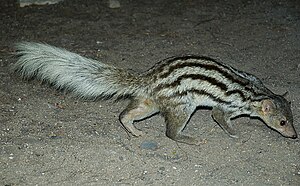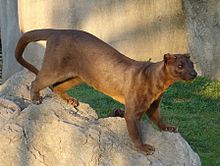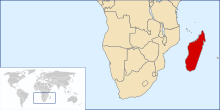Malagasy predators
| Malagasy predators | ||||||||||||
|---|---|---|---|---|---|---|---|---|---|---|---|---|

Greater broad-striped mongoose ( Galidictis grandidieri ) |
||||||||||||
| Systematics | ||||||||||||
|
||||||||||||
| Scientific name | ||||||||||||
| Eupleridae | ||||||||||||
| Chenu , 1852 |
The Malagasy carnivores (Eupleridae) are a family of carnivores (Carnivora) living in Madagascar . It encompasses all of the naturally occurring predators on this island, and it was only at the beginning of the 21st century that it was established based on molecular genetic studies. It is a very diverse group in terms of body shapes and lifestyles, but most species are solitary carnivores. The family includes eight living species and one species that has been extinct in the last millennia.
features

There are no morphological characteristics that clearly distinguish the Malagasy predators from the other predators. Rather, they show convergences to various other groups of predators, such as cats , crawling cats or mongooses , which was the reason why the relationship of these animals could not be identified on the basis of external criteria. The largest representative is the fossa with a head trunk length of up to 80 centimeters and a weight of up to 12 kilograms, while the smallest Madagascar mongooses have a head trunk length of 26 centimeters and a weight of 500 grams. The males and females of the Malagasy carnivores do not differ in the color of their fur, but in some species they differ in their dimensions - in these cases the males are larger.
In general, the physique of these animals is slim and elongated, the limbs are short. The paws are often relatively large, the claws can be retractable - for example in the case of the fossa - or not. The fur is short and dense, it is held in different gray or brown tones. In some species, it is patterned with spots or stripes. The tail is slightly shorter than the body, it is bushy in the majority of species and can - for example in the ring -tailed mongoose - show signal coloring.
The head is rather small compared to the rest of the body. In most species it is characterized by the pointed snout, whereas in the fossa it is similar to a cat with its short facial skull. The crushing scissors from the last upper premolar and the first lower molar ("fangs"), a predator characteristic, are not very pronounced with the exception of the fossa. The Falanuk differs significantly from the other species with its uniform, insect- eater-like dentition.
distribution and habitat

The Madagascan predators are endemic to Madagascar off the east coast of Africa , they do not occur on the small offshore islands. They are the only predators that naturally live on this island, although the domestic cat , the house dog and the Indian civet were introduced there by humans . The habitat of the Madagascan predators are mainly forests, although they can live in various forest forms. They can be found in the rainforests of the east coast as well as in the deciduous forests in the west and the thorn forests in the southwest of the island. Six of the species are strict forest dwellers, only the fossa and, to a lesser extent, the ring-tailed mongoose sometimes look for food in unforested areas or at forest edges or use them as transit areas. These two species are also the most undemanding in terms of their habitat and can be found in different forest forms, while most of the other species specialize in a certain forest type as a habitat .
The biodiversity is highest in the rainforests of the east coast, here there are sometimes up to five sympatric species . The western and southwestern forests have lower biodiversity, but possibly higher population densities.
Way of life
Activity times and movement

The way of life of the Malagasy predators is variable. Some species have a cathemeral way of life, that is, they do not have a pronounced day-night rhythm. Other animals, such as the broad-striped mongoose or the Fanaloka, are primarily nocturnal. Hollow tree trunks, caves in the ground, crevices in the rock or structures they have dug themselves serve as resting places. Malagasy predators are primarily terrestrial , that is, they live predominantly on the ground, most species can climb well, some also swim. The locomotion can be on the toes (digitigrad) as well as sole walkers (plantigrad).
Some species show adaptations to the seasonal climate of Madagascar. In this way, the fossa in your body and the falanuk in its tail can build up fat reserves, and the body weight increases by up to 25%. These reserves are created in the rainy season in order to be better able to survive the cool and nutrient-poor dry season . However, there is no evidence of rigidity or hibernation for any species .
Social and territorial behavior
Social behavior is also variable, but hardly known for many species. Of the species that have been better researched, the fossa lives solitary and the ring-tailed mongoose in family groups of a male, a female and up to three juveniles. There have also been observations of two or more animals living together of other species, these are probably mothers with their young. Apart from the ring-tailed mongoose, no other species is known in which the males take an active part in rearing young, they probably live solitary outside the mating season.
Malagasy predators are mostly territorial animals that mark their territories with glandular secretions . As with carnivores, the territories are generally relatively large, with the fossa, for example, they can cover up to 26 km². The olfactory communication with scent traces generally plays an important role in these animals, on the other hand many species are quiet animals that make little noise. Exceptions are the more social ring-tailed mongooses, which have a diverse sound repertoire.
food
Malagasy predators are mainly carnivores , and their diet can vary significantly depending on their habitat and season. The fossa, the largest Madagascan predator, is equipped with strong teeth and mainly eats vertebrates, including lemurs . The falanouc adapted with its small teeth on soft food and takes mainly earthworms to himself. The remaining species, all of which weigh less than 2 kilograms, consume small vertebrates as well as insects and other invertebrates and are often food generalists. Some species also eat carrion and, on a small scale, eat plant foods such as fruits.
Reproduction
Reproduction is seasonal, at least for some species, so that births fall in the rainy season when the food supply is greatest. The gestation period is 40 to 105 days, depending on the species, but the information is partly contradictory. The litter sizes are small with one or two, only with the fossa it can be up to four young animals. The newborns usually spend their first weeks of life in a burrow or in another shelter. The degree of development of newborns different, so are the offspring of Fossas Nesthocker while in Fanaloka and partly also in Madagascar mongooses precocial are. Weaning takes place between two and four and a half months of age. There is hardly any information about life expectancy in the wild; Fossas and ring-tailed mongooses can live for over 20 years in human care.
Malagasy predators and humans
Since the Madagascan predators are predominantly forest inhabitants, they are endangered by the progressive destruction of their habitat due to slash and burn , deforestation , charcoal production and mining . Another factor is competition from introduced species such as the domestic dog or the Indian civet cat . In addition, there is hunting: on the one hand, they are hunted for their meat, on the other hand, because they have a reputation for invading houses and stables and killing poultry and other small domestic animals. It is not known to what extent these incidents are actually caused by the Malagasy predators or whether the introduced predators are responsible. In Malagasy folklore there are stories that fossas are sometimes a threat to humans. However, there are no reliable reports of attacks on people.
One species, the giant fossa , has become extinct over the past millennia. The IUCN lists some sort, the Great Wide Stripe Mungo , "highly endangered" ( endangered ); three species, fossa , narrow-striped mongoose and plain mongoose , as "endangered" ( vulnerable ); three other species, broad-striped mongoose , Falanuk and Fanaloka , as " near threatened " and only one species, the ring-tailed mongoose , as not endangered.
Systematics and history of development
Internal systematics and taxonomic past
The Malagasy carnivores comprise seven genera with nine living and one extinct species , which are divided into two subfamilies:
- Subfamily Madagascar mongooses (Galidiinae)
- Ring- tailed Mongoose ( Galidia elegans )
- Genus broad-striped mungos ( Galidictis )
- Broad-striped mongoose ( Galidictis fasciatus )
- Greater broad-striped mongoose ( Galidictis grandidieri )
- Narrow-striped mongoose ( Mungotictis decemlineata )
- Genus Salanoia
- Plain mongoose ( Salanoia concolor )
- Salanoia durrelli
- Subfamily Euplerinae
- Genus Cryptoprocta
- Fossa ( Cryptoprocta ferox )
- Giant fossa ( Cryptoprocta spelea ) †
- Falanuk or sneaky ant ( Eupleres goudotii )
- Fanaloka ( fossa fossana )
- Genus Cryptoprocta
While the genetic findings clearly indicate that the Malagasy carnivores are a monophyletic group, that is, descended from a common ancestor, the internal systematics is more controversial. The Madagascar mongooses probably also form a monophyletic group - although the exact position of the mongoose is not known. Fossa and Fanaloka are closely related, the position of the Falanuk is controversial, so that it is not clear whether the Euplerinae are also monophyletic. One possible cladogram of Malagasy predators looks like this:
| Malagasy carnivores (Eupleridae) |
|
||||||||||||||||||||||||||||||
|
|
Due to differences in morphology and way of life, Madagascar's predatory species were previously divided into three groups: the Madagascar mongooses were considered to be the subfamily Galidiinae of the mongooses (Herpestidae), which contrasted with the mongoose species of mainland Africa and Asia (Herpestinae). Falanuk and Fanaloka were assigned to the crawling cats (Viverridae) as the subfamily Euplerinae , whereby the Falanuk was even regarded as a representative of insectivores and not of predators when it was first described in 1835 . The taxonomic affiliation of the fossa was controversial. It was usually led in its own subfamily, Cryptoproctinae, which due to some cat-like characteristics were sometimes counted among the cats (Felidae), but mostly also among the crawling cats or mongooses.
External system and history of development
In 2003, Anne Yoder et al. a comprehensive molecular genetic study in which the systematic position of the predators native to Madagascar was investigated using two mitochondrial and two nuclear genes. Contrary to the previously suspected parentage, the investigation showed that the Madagascan predators form a monophyletic group despite all morphological differences. In 2005, a study by Philippe Gaubert et al. Found that purely morphological criteria do not support the monophyly of Malagasy predators, which is why it was proposed to at least divide it into several families. The more recent taxonomic publications, however, recognize the Eupleridae as a whole and carry out the ones proposed by Gaubert et al. proposed division not through.
The studies by Yoder et al. showed that the mongooses (Herpestidae) are the sister group of the Malagasy predators and the hyenas (Hyaenidae) are the sister group of the clade of mongooses and Malagasy predators. Accordingly, there is only a distant relationship with the crawling cats or cats.
The question of how the Malagasy predators came to Madagascar is discussed. Since they are a monophyletic group, a single settlement process can be assumed. The island, located 400 kilometers off the east coast of Africa, is home to a peculiar and limited mammal fauna; land-bound mammals from only five taxa occur naturally here, the lemurs , the tenreks , the Madagascar rats , the Madagascan predators and Malagasy hippos . Since the land bridge hypothesis popular in the 19th century is considered obsolete in view of plate tectonics , the most plausible method remains the sea route, either floating or on floating vegetation.
However, such a transport is a great challenge for the animals. They have to survive for a long time without food and water and arrive in a larger group in order to find a reproductive partner there. As mentioned above, some Malagasy predators can build up fat stores to help them get through times of poorer nutrition. Even if there is no longer any evidence of hibernation in today's species, it is conceivable that animals with fat reserves and in a resting or sleeping state would most likely survive such a journey. Using the molecular clock , Anne Yoder calculates the time of the animals' arrival in Madagascar to be between 24 and 18 million years ago, i.e. in the late Oligocene or early Miocene .
There are no known vertebrate fossils in Madagascar from the period between the end of the Cretaceous Period (around 65 million years ago) and the late Pleistocene or early Holocene (around 12,000 years ago). So no conclusions about the evolutionary history of these animals can be drawn from fossils.
literature
- Steven M. Goodman: Family Eupleridae (Madagascar Carnivores). In: Don E. Wilson, Russell A. Mittermeier (eds.): Handbook of the Mammals of the World. Volume 1: Carnivores. Lynx Edicions, 2009, ISBN 978-84-96553-49-1 , pp. 330-351.
- Nick Garbutt: Mammals of Madagascar. A Complete Guide. Yale University Press, New Haven & London 2007, ISBN 978-0-300-12550-4
- Ronald M. Nowak: Walker's Mammals of the World. The Johns Hopkins University Press, Baltimore 1999, ISBN 0-8018-5789-9 . (The Eupleridae do not yet know about the individual genera)
- WC Wozencraft: Order Carnivora. In: DE Wilson, DM Reeder (Ed.): Mammal Species of the World . , 3. Edition. Johns Hopkins University Press, Baltimore 2005, ISBN 0-8018-8221-4 , pp. 532-628.
Individual evidence
- ↑ Goodman (2009), p. 334.
- ↑ Goodman (2009), pp. 335-336.
- ↑ Goodman (2009), p. 331.
- ↑ Garbutt (2007), p. 212.
- ↑ Goodman (2009), pp. 341-342.
- ↑ Garbutt (2007), p. 214
- ↑ Search for “Eupleridae” in the IUCN's Red List of Threatened Species . Retrieved June 23, 2009.
- ↑ J. Durbin, SM Funk, F. Hawkins, DM Hills: Investigations into the status of a new taxon of Salanoia (Mammalia: Carnivora: Eupleridae) from the marshes of Lac Alaotra, Madagascar. Systematics and Biodiversity 8 (3), September 2010, 341–355 doi: 10.1080 / 14772001003756751
- ↑ a b c d Anne D. Yoder, Melissa M. Burns, Sarah Zehr, Thomas Delefosse, Geraldine Veron, Steven M. Goodman and John J. Flynn: Single origin of Malagasy Carnivora from an African ancestor. In: Nature 421 (2003), pp. 734-737. PDF
- ↑ a b c see Nowak (1999).
- ^ A b P. Gaubert, W. Wozencraft, P. Cordeiro-Estrela and G. Veron: Mosaics of convergences and noise in morphological phylogenies: What's in a viverrid-like carnivoran ?. In: Systematic Biology, 54 (6), 2005, pp. 865-894. PDF ( page no longer available , search in web archives ) Info: The link was automatically marked as defective. Please check the link according to the instructions and then remove this notice.
- ↑ for example: G. Veron: La position systématique de Cryptoprocta ferox (Carnivora). Analysis cladistique des charactères morphologiques de carnivores Aeluroidea actuels et fossiles. In: Mammalia, 59, pp. 551-582 (1995)
- ↑ for example: WC Wozencraft: Order Carnivora. In: DE Wilson and DM Reeder, (Eds.) Mammals Species of the World: a taxonomic and geographic reference, Washington, Smithsonian Institution Press 1993, pp. 279-344.
- ↑ e.g. Wozencraft (2005) or Goodman (2009)
- ^ Goodman (200), p. 333.
Web links
- Information at Animal Diversity Web (English)

